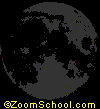
 |
| You might also like: | Craters- The Moon | Moon Map - Zoom Astronomy | Crescent Moon: Perimeter Poem - Printable Worksheet. | Inside the Moon - Zoom Astronomy | Moon Quiz and Research Activity | Today's featured page: Cicada |
| Our subscribers' grade-level estimate for this page: 4th - 5th |
| Table of Contents | Enchanted Learning All About Astronomy |
Site Index |
| Our Solar System | Stars | Glossary | Printables, Worksheets, and Activities | ||||||
| The Sun | The Planets | The Moon | Asteroids | Kuiper Belt | Comets | Meteors | Astronomers | ||
| The Moon |
| General Description |
Inside the Moon | Craters | Phases of the Moon | Why Do We See Only One Side of the Moon? | Tides | Activities, Web Links |
| Map | Lunar Eclipses |
 The moon is Earth's only natural satellite. The moon is a cold, dry orb whose surface is studded with craters and strewn with rocks and dust (called regolith). The moon has no atmosphere. Recent lunar missions indicate that there might be some frozen ice at the poles.
The moon is Earth's only natural satellite. The moon is a cold, dry orb whose surface is studded with craters and strewn with rocks and dust (called regolith). The moon has no atmosphere. Recent lunar missions indicate that there might be some frozen ice at the poles.
The lunar crater Aristarchus ( on the NW edge of the Oceanus Procellarum). This huge, circular crater is 25 miles (40 km) in diameter and 2.2 miles (3.6 km) deep (from rim to floor). There is a lot of ejecta (material thrown from the crater at impact) surrounding the crater. |
TWO LUNAR MONTHS
The sidereal and synodic lunar months have different lengths. The sidereal month is the amount of time it takes the Moon to return to the same position in the sky with respect to the stars; the sidereal month is 27.321 days long. The synodic month is the time between similar lunar phases (e.g., between two full moons); the synodic month is 29.530 days long.
LUNAR EXPLORATION
Astronaut Buzz Aldrin's footprint on the moon's Sea of Tranquility, from the Apollo 11 mission in 1969. |
Moon Phases Calendar One-month moon phases calendar page to print - horizontal or vertical orientation. Students can observe and draw the phases of the moon for a month. |
Printout: Moon coloring page Color the moon, including its inner structure. |
Printout: Earth and Moon coloring page Color the moon and the Earth. |
SUN-EARTH-MOON MODEL Make a model of the Sun, Earth, and moon that shows the Earth orbiting the Sun, with the moon circling the Earth. |
Printout: Moon Quiz Take a short quiz on the moon. |
Lunar Eclipse Diagram Label the lunar eclipse. Answers |
Moon Phases Diagram Label the phases of the waxing and waning moon. Answers |
 Interactive Moon Quiz Puzzle An interactive puzzle on the moon. |
 K-3 Moon Theme Page Rhymes, information, and printouts on the moon. |
Moon Definition - Multiple Choice Comprehension Quiz Answer 8 multiple choice questions on the definition of moon; a lesson in using a dictionary. Go to the answers. |
Write Moon-Related Definitions In this worksheet, write the definition of a word, what part of speech it is, and use it in a sentence. Words: lunar, lunar phase, new moon, full moon, gibbous, waning, half-moon, lunar eclipse, crater, lunar mare. Or go to the answers. Or go to a pdf of the questions and answers (subscribers only). |
Write Ten Things About the Moon A one-page printable worksheet. Write ten things about the moon (plus one thing you would like to change about it). |
Write a Moon Acrostic Poem Write a poem about the moon. Start each line with a letter from the word "moon." |
MOON AND STAR CUT-OUTS Make metal cut-out ornaments from a disposable aluminum pie plate. |
Draw and Compare Day and Night Draw the daytime sky and the night sky and then answer simple questions comparing them, for example, "Which one do you see more often?" |
Flags Featuring a Crescent Moon A page of flags from around the world that feature a crescent moon. |
Enchanted Learning®
Over 35,000 Web Pages
Sample Pages for Prospective Subscribers, or click below
|
Overview of Site What's New Enchanted Learning Home Monthly Activity Calendar Books to Print Site Index K-3 Crafts K-3 Themes Little Explorers Picture dictionary PreK/K Activities Rebus Rhymes Stories Writing Cloze Activities Essay Topics Newspaper Writing Activities Parts of Speech Fiction The Test of Time
|
Biology Animal Printouts Biology Label Printouts Biomes Birds Butterflies Dinosaurs Food Chain Human Anatomy Mammals Plants Rainforests Sharks Whales Physical Sciences: K-12 Astronomy The Earth Geology Hurricanes Landforms Oceans Tsunami Volcano |
Languages Dutch French German Italian Japanese (Romaji) Portuguese Spanish Swedish Geography/History Explorers Flags Geography Inventors US History Other Topics Art and Artists Calendars College Finder Crafts Graphic Organizers Label Me! Printouts Math Music Word Wheels |
Click to read our Privacy Policy
| Search the Enchanted Learning website for: |